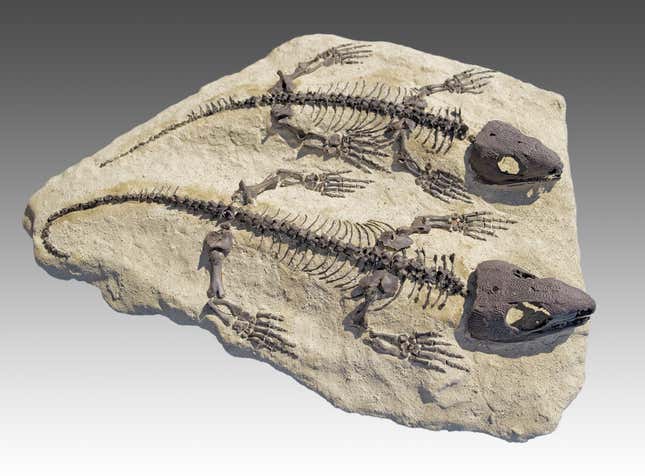Researchers believe they’ve found the oldest known fossilized skin, hidden away in a limestone cave system in Oklahoma. The skin sample dates to the early Permian Period, between 289 million years ago and 286 million years ago.
The skin belonged to an ancient reptile and is epidermis—the outer layer of skin in amniotes, a group that includes terrestrial reptiles, mammals, and birds. A study describing the skin as well as several other fossils found in the cave system is published today in Current Biology.
According to the research team, the recently discovered skin—smaller than a fingernail—is the first-known skin-cast fossil from the Paleozoic Era. The other fossils included skin compressions, skin bits from the ancient reptile Captorhinus aguti, and several scales of anamniotes—animals that reproduce in water. The bands of skin from the fossilized C. aguti came from just behind the animal’s head; the team was not able to associate all the amniote skin with specific ancient creatures.
The epidermis is easy to overlook, but it protects the body from the harsh external world. It is the outermost layer of skin, keeping us hydrated and shielding us from everything from bacteria to extreme temperatures. The ancient skin studied by the team (and originally recovered in the cave and donated by Bill and Julie May) appears to have served a similar purpose for its ancient reptilian host.

All skin samples found in the cave were preserved thanks to some serendipitous circumstances. “Animals would have fallen into this cave system during the early Permian and been buried in very fine clay sediments that delayed the decay process,” said Ethan Mooney, a paleontologist at the University of Toronto and lead author of the paper, in a Cell release. “But the kicker is that this cave system was also an active oil seepage site during the Permian, and interactions between hydrocarbons in petroleum and tar are likely what allowed this skin to be preserved.”
Under the microscope, the skin’s surface bears similarities to crocodile skin, with hinges between scales similar to those seen in extant snakes and worm lizards. In the paper, the team notes that the skin’s morphology and its superlative age indicate that “this important organ for terrestrial vertebrate life was already present at the initial stages of amniote diversification.” That is, the epidermis already existed when early amniotes began to branch out into different forms of life.
Ancient reptiles have a dynamic history that can be extricated from fossils. In 2022, a team revealed a 150-million-year-old fossil from Wyoming that clarified the evolutionary timeline of rhynchocephalians, a unique group of reptiles that has one living member: the tuatara. Of course, the recently analyzed skin is about twice as old as that ancient reptile, in a sobering reminder of how ‘deep’ deep time really is.
More: Researchers Test 2,400-Year-Old Leather and Realize It’s Made of Human Skin

